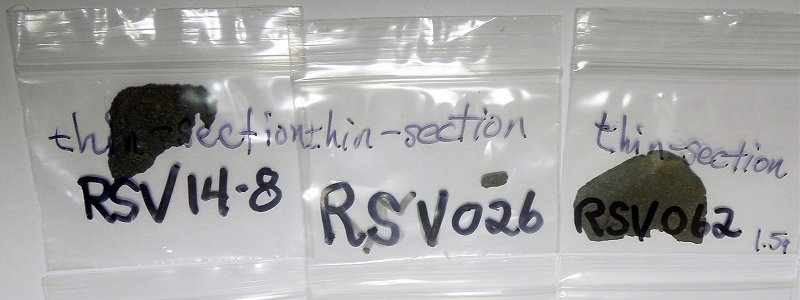![]()
Bob's Bulletin - Vol. 1 No. 2
A newsletter for "orphaned" meteorites from the USA.

In my previous article, I introduced the phrase "orphaned-meteorites from the USA". I defined these "orphans" as being non-fall Ordinary Chondrite (OC) meteorite "finds" that are recovered in the U.S.
Unfortunately, the vast majority of finds are of this type.
It wasn't very long ago that this (being an OC) wouldn't have been a problem. There was a time when U.S. meteorite finds were rare, and researchers would compete for the honor of classifiying those meteorites But now, we are in an era known as the "NWA glut", and the researchers that are designated as official "classifiers" are charging meteorite finders and dealers for these once free "classifications". And worse, more and more classifiers are turning away OCs, opting instead, to triage only achondrites/irons, or fresh falls.
Now this is where we enter a sort-of "catch-22". And it's for this reason: if a meteorite find can't get classified, then it can't get a name assigned to it, because getting an approved-name is contingent upon getting a classification. If a meteorite doesn't have an approved-name, it can't be cataloged. Researchers avoid studying un-cataloged meteorites, because editors require "approved-names" in their publications. Consequently, unclassified finds are "orphaned" from the family of "approved" meteorites.
And now these "orphans" are increasing in number, due to these recent changes. Partly, because of the increasing costs to get a find classified, but mostly, because more and more classifiers are declining to classify Ordinary Chondrites.
It was at this point in my last article that I explained why most U.S. taxpayers don't realize that none of their tax dollars are spent on the recovery or classification of meteorites found in the USA. I explained that, although it is well-known that tax dollars are spent to maintain a repository for Moon-rocks recovered from NASA's Apollo Program, as well as, for meteorites recovered from Antarctica, most U.S. taxpayers are unaware that there are no tax dollars set aside to fund the recovery and classification of U.S. meteorite finds. The paltry amount used by the Smithsonian Institute to curate their (our) meteorite collection doesn't even merit discussion here, but only makes my point that qualified researchers are not funded to classify meteorites (particularly Ordinary Chondrites), and this includes meteorites found in the U.S.
I went on to explain what this means: "Should you be lucky enough to find a meteorite here in the USA, you'll have to make a serious donation in order to entice a researcher to study your find, and in the end you will be essentially paying for its classification. Worse, what now appears to be common practice, these researchers are turning down Ordinary Chondrites and are refusing to classify them, even when they are getting paid to do the classifications. And since the vast majority of meteorites that are found here in the USA are Ordinary Chondrites, the vast majority of future USA meteorite finds will never get classified or cataloged. This means that they will never get officially recognized or cataloged, and consequently will be exempt from use by researchers in their published papers."
I call these meteorites, "orphans", because they will soon be lost to the ages. "
In this edition of Bob's Findings I've re-explained the definition of "orphaned-meteorites", and I'm now introducing in this newsletter-format the next five "orphaned" U.S. meteorite finds:
| Field ID Number | C070106A |
|---|---|
| Newsletter | 01-2 |
| Location | California, USA |
| Thin-section ID Number | V071 |
| Dimensions | 4.5cm x 4cm x 3.5cm |
| Weight | 121.4 grams |
| Type Specimen | 27 gram endcut - plus thin-section |
| Class | Ordinary Chondrite |
| high (very likely above "W3") | |
| low (most likely "S2" or lower) | |
| Macroscopic Description -- R. Verish | |
| The dark, grayish-brown exterior of this chondrite has no fusion crust. In fact, several chondrules are quite visible, standing in high relief, suggesting that the groundmass is not very resistant to weathering.The interior is a dark-brown, porous matrix with low metal-grain content and the chondrules and inclusions are quite variable in size. | |
| Thin Section Description -- R. Verish | |
| The section exhibits a variety of chondule sizes (some up to 3 mm), and most are somewhat-defined in a dark-brown, iron oxide-rich matrix of fine-grained silicates, troilite and rare metal. The meteorite is highly weathered. Very weak mosaic shock effects are present. Silicates are equilibrated. This meteorite is probably a low-shock, equilbrated H-chondrite. | |
The above example is one way in which I can bring attention to what I predict will be an increasing number of unclassified meteorites found here in the USA. Hopefully, attention will be drawn to what I see as a growing problem, and maybe some institution will offer to help get some of these orphans classified and cataloged.
Meteoritical Bulletin: the search results for all provisional meteorites found in "USA" - Published by Meteoritical Society - Meteoritical Bulletin, Database.
Meteorites of California the list of formally-recognized California meteorite falls and finds.
My previous articles can be found *HERE*
For for more information, please contact me by email:
Bolide*chaser
